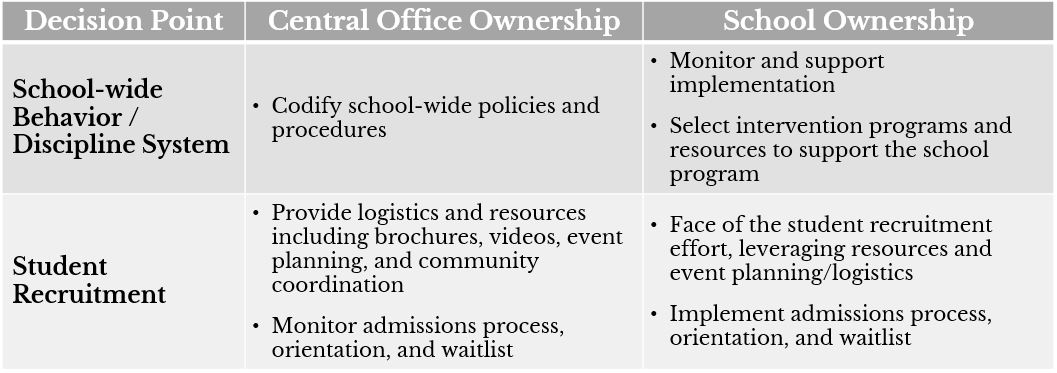School systems we work with here at Afton are increasingly including “autonomy” policies for principals in their strategic plans for academic achievement – meaning giving them more decision making authority. Often, this is in the form of bounded or earned autonomy, wherein principals receive additional decision making authority based on demonstrated readiness.
For example, a school principal with an innovative instructional delivery idea might earn control over how many of what types of staffing positions their school will operate with (up to a defined cost ceiling) rather than be assigned specific positions by central office. School systems may provide principals with more of these kinds of “autonomies” as levers to improve lower-performing schools, promote innovation, increase hyper-local ownership, and/or for development of strong leaders.
Simply being intentional about assigning specific decision making authorities to school principals and central office can contribute to meeting district-wide and school accountability goals. As noted in the recent publication by Public Impact: “Autonomous District Schools: A New Path to Growing High-Quality, Innovative Public Schools” (full report here), school systems can consider formalizing autonomous relationships with their schools.
Without clear governance agreements, policies, or other formal establishments of decision making authority guidelines, there may be confusion over responsibilities, making it difficult to effectively oversee school improvement strategies. To get to a clarified view of decision making authority in a school system, consider this example below of a school system’s decisions matrix.

Four major decision categories were identified as Academics, Culture, Operations, and Finance and underneath each category, several types of decision areas were identified. For each of these decision types, the school system identified the role of the central office and the role of schools. Two examples of culture-related decisions and the corresponding roles of central office and principals were articulated as follows:

As school systems define their decision making authorities between schools and central office, they strengthen their ability to implement and oversee school improvements. School systems can take it a step further by aligning financial practices and policies to the decision making authorities. For example, if a school system decides to assign responsibility for student recruitment to school principals, the school system could provide them with the spending authority to repurpose funds toward any number of ideas they may have to recruit students. Compensation and procurement policies could also be reviewed to determine how they might further the implementation of these kinds of autonomy decisions.
After all, how can we reasonably expect district-wide and school improvements without giving clear lines of authority and resource allocation rights to those we ask to be responsible for the results?